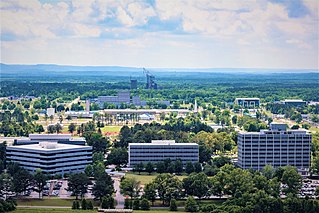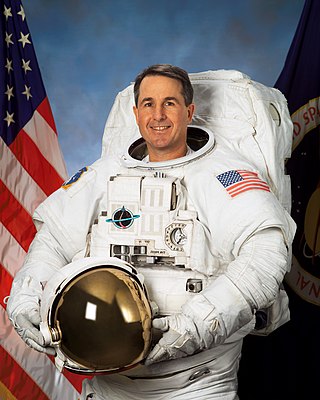
The George C. Marshall Space Flight Center (MSFC), located in Redstone Arsenal, Alabama, is the U.S. government's civilian rocketry and spacecraft propulsion research center. As the largest NASA center, MSFC's first mission was developing the Saturn launch vehicles for the Apollo program. Marshall has been the lead center for the Space Shuttle main propulsion and external tank; payloads and related crew training; International Space Station (ISS) design and assembly; computers, networks, and information management; and the Space Launch System (SLS). Located on the Redstone Arsenal near Huntsville, MSFC is named in honor of General of the Army George C. Marshall.

Guion Stewart Bluford Jr. is an American aerospace engineer, retired United States Air Force (USAF) officer and fighter pilot, and former NASA astronaut, in which capacity he became the first African American to go to space. While assigned to NASA, he remained a USAF officer rising to the rank of colonel. He participated in four Space Shuttle flights between 1983 and 1992. In 1983, as a member of the crew of the Orbiter Challenger on the mission STS-8, he became the first African American in space as well as the second person of African descent in space, after Cuban cosmonaut Arnaldo Tamayo Méndez.

Sandra Hall Magnus is an American engineer and a former NASA astronaut. She returned to Earth with the crew of STS-119 Discovery on March 28, 2009, after having spent 134 days in orbit. She was assigned to the crew of STS-135, the final mission of the Space Shuttle. She is also a licensed amateur radio operator with the call sign KE5FYE. From 2012 until 2018 Magnus was the executive director of the American Institute of Aeronautics and Astronautics.

Henry Warren Hartsfield Jr. was a United States Air Force Colonel and NASA astronaut who logged over 480 hours in space. He was inducted into the United States Astronaut Hall of Fame in 2006.

Stephen Kern Robinson is an American former NASA astronaut.

Nancy Jan Davis is a former American astronaut. A veteran of three space flights, Davis logged over 673 hours in space. She is now retired from NASA.

Owen Kay Garriott was an American electrical engineer and NASA astronaut, who spent 60 days aboard the Skylab space station in 1973 during the Skylab 3 mission, and 10 days aboard Spacelab-1 on a Space Shuttle mission in 1983.

Byron Kurt Lichtenberg, Sc. D. is an American engineer and fighter pilot who flew aboard two NASA Space Shuttle missions as a Payload Specialist. In 1983, he and Ulf Merbold became the first Payload Specialists to fly on the shuttle.

Jeffrey Alan Hoffman is an American former NASA astronaut and currently a professor of aeronautics and astronautics at MIT.

Bonnie Jeanne Dunbar is an American engineer and retired NASA astronaut. She flew on five Space Shuttle missions between 1985 and 1998, including two dockings with the Mir space station.

Anthony Wayne England, better known as Tony England, is an American, former NASA astronaut. Selected in 1967, England was among a group of astronauts who served as backups during the Apollo and Skylab programs. Like most others in his class, he flew during the Space Shuttle program, serving as a mission specialist on STS-51-F in 1985. He has logged more than 4,000 hours of flying time and 188 hours in space.

Fred Weldon Leslie is an American scientist who flew on the NASA STS-73 Space Shuttle mission as a payload specialist.

Kathryn Ryan Cordell Thornton is an American scientist and a former NASA astronaut with over 975 hours in space, including 21 hours of extravehicular activity. She was the associate dean for graduate programs at the University of Virginia School of Engineering and Applied Science, currently a professor of mechanical and aerospace engineering.

Dr. Jerrol Wayne Littles was the eighth director of the NASA Marshall Space Flight Center located in Huntsville, Alabama. He served as director from February 3, 1996, to January 3, 1998.

Axel Roth was born in Darmstadt, Germany, on October 25, 1936. He was the son of Ludwig Roth, an original member, of the German Rocket Team. He survived World War II, RAF bombing of rocket development facility at Peenemünde, Germany, August 17–18, 1943, known as Operation Crossbow. He arrived in the US in New York City, NY in 1946, a year after his father arrived there as part of Operation Paperclip, aboard a converted troop transport. He moved first to Ft. Bliss, Texas, and then to Huntsville, Alabama in 1950 when the German Rocket Team was relocated to Redstone Arsenal, Alabama.

John L. Junkins is an American academic and a distinguished professor of aerospace engineering in the College of Engineering at Texas A&M University specializing in spacecraft navigation, guidance, dynamics, and control. He holds the Royce E. Wisenbaker Endowed Chair at Texas A&M University and also serves as the Founding Director of the Hagler Institute for Advanced Study at Texas A&M University, since its founding in December 2010. On November 24, 2020, Junkins was announced as the interim President of Texas A&M University starting January 2021. He was the interim president until May 31, 2021.

Joseph Majdalani is an Lebanese-American professor of Mechanical and Aerospace Engineering. He began his career at Marquette University, before serving as both the Jack D. Whitfield Professor of High Speed Flows and Arnold Chair of Excellence at the University of Tennessee Space Institute. He then served as the Auburn Alumni Engineering Council Endowed Professor and Chair, and is currently the Hugh and Loeda Francis Chair of Excellence in Aerospace Engineering at Auburn University.

Mary Helen Johnston, later also Mary Helen McCay, is an American scientist and former astronaut. Working with NASA as an engineer in the 1960s and '70s, Johnston aspired to be an astronaut; she unsuccessfully applied in 1980 before becoming a payload specialist in 1983. Johnston retired from NASA in 1986 without having gone to space. She is a professor at Florida Institute of Technology.
Robert "Bob" S. Ryan is an American engineer who worked for NASA designing launch vehicles and coordinating technical training.


















